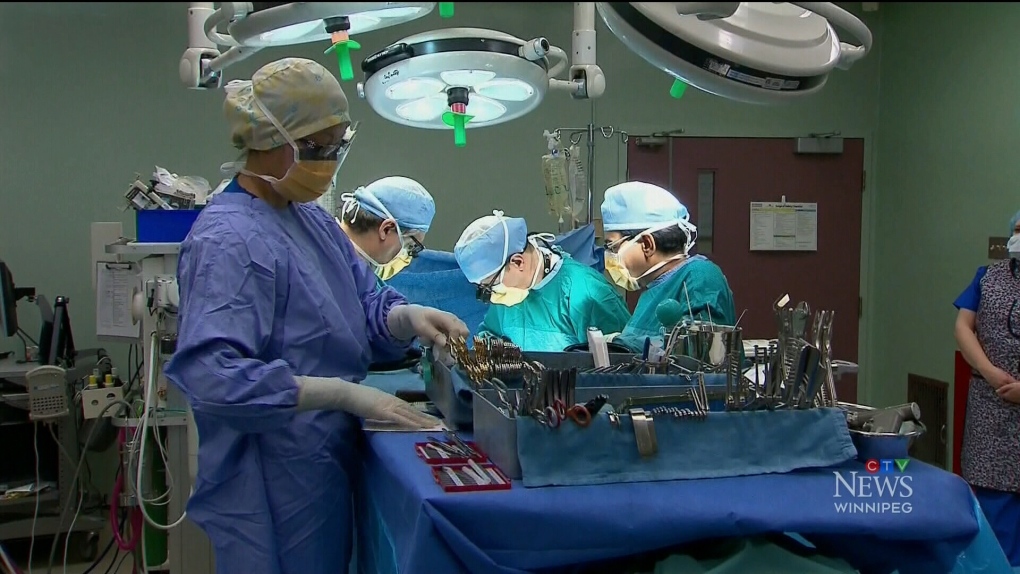MRI and ultrasound waitlists increase as Manitoba touts progress in surgical backlog
The new leader of Manitoba's Diagnostic and Surgical Recovery Task Force says progress is being made to cut back the pandemic surgical backlog, however provincial data shows waitlists are increasing for ultrasounds and MRIs.
On Thursday, former Interlake-Eastern Regional Health Authority CEO David Matear announced he would be taking over the task force’s helm as the new provincial executive director.
"My vision for the taskforce is that we make measurable progress on addressing backlogs that resulted from the pandemic, while also contributing significant improvements to the health-care system," Matear said, adding he has been in the new role since last week.
According to the province, while the waitlist for CT scans dropped from 17,063 in February to 16,546 in April, the waitlist for ultrasounds and MRIs both increased.
As of Wednesday, the ultrasounds waitlist increased to 20,854 (up from 20,626 as of Feb. 28), and the MRI waitlist increased to 15,754 (up from 15,282 as of Feb. 28).
Matear said the task force has received dozens of proposals aimed at reducing this backlog and is currently working through them.
He said last month, eligible patients began travelling from Manitoba to Sanford Health in Fargo for specialty spine services. As of Thursday, Matear said 15 patients have received care through this initiative, with several more patients scheduled to make the trip.
Additionally, he said the fecal immunochemical testing (FIT) began as of last week. This allows doctors to refer patients with lower risk of colorectal cancer to FIT testing, which Matear said will help reduce the number of follow-up colonoscopies by at least of 10,000, accounting for about 10 per cent of the backlog.
He said the taskforce has received dozens of proposals aimed at reducing the backlog and is currently working through them.
He said the goal is to bring surgeries back to 100 per cent of the pre-pandemic level.
"As soon as you get to that point, in essence what you are doing is you are slowing the growth of the backlog. So we are trying to do everything to reduce the growth of the backlog," Matear said, adding as of Sunday surgical activity in Winnipeg was at about 97 per cent of pre-pandemic levels.
"The more we get to that 100 per cent level, the slower the backlog will increase."
Must Watch
Top Videos
CTVNews.ca Top Stories

BREAKING Justin Trudeau stepping down as Liberal leader, to stay on as PM for now
Prime Minister Justin Trudeau is stepping down as Liberal leader, and is proroguing Parliament as the Liberal Party of Canada embarks on the journey to replace him.
3 min ago
WATCH LIVE Live updates as Justin Trudeau resigns as Liberal Leader
Prime Minister Justin Trudeau has stepped down as Liberal leader. Follow along for live updates from CTVNews.ca.
2 min ago
W5 INVESTIGATES One Canadian couple's fight against a contractor who defrauded them
Pull into the driveway at John and Julie Ridley's house and you'll notice large patches of red siding are missing from their house and garage. What was supposed to be a dream retirement home for the couple is now a daily reminder of what went wrong.
5 hours ago
UPDATED | Winter storm warnings in effect for most of Canada. Here's where
A weekend winter storm that brought much of Canada under severe weather alerts continues to bring chilly conditions to Canadians across the country.
10 min ago
U.S. Postal Service accepting mail and packages to Canada again following strike
The United States Postal Service is resuming accepting mail and packages to Canada following the end to service disruptions from the month-long Canada Post strike.
1 hour ago
opinion What you need to know about filing your taxes in 2025
This year, there are several changes to be aware of when filing your 2024 taxes. Personal finance contributor Christopher Liew outlines the key changes to keep in mind as the tax deadline approaches.
2 hours ago
Visitors to the U.K. from 48 countries must now apply and pay a fee before travel
The U.K. will introduce its ETA system on Jan. 8. ETA, which stands for Electronic Travel Authorisation, is a new digital registration scheme for travelers who don’t need a visa to enter the U.K.
2 hours ago
Court orders WestJet to hand over flight attendant harassment files in lawsuit
The B.C. Supreme Court has ordered WestJet to hand over all its files on harassment of flight attendants, in a class-action lawsuit alleging widespread misconduct by pilots.
2 hours ago
Men convicted in death of family crossing Manitoba border seek acquittal, new trial
The two men found guilty of human smuggling in the case of a family from India who froze to death while trying to walk across the Canada-U.S. border in Manitoba in 2022 are seeking acquittal, or new trials.
1 hour ago



















































